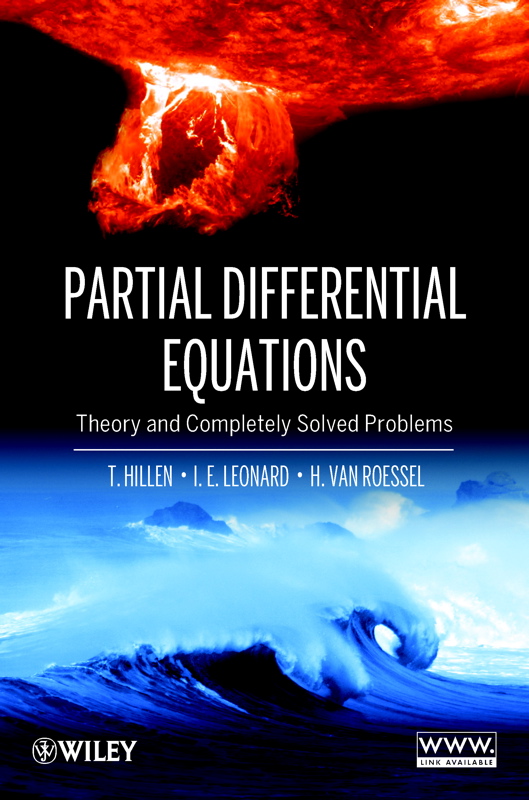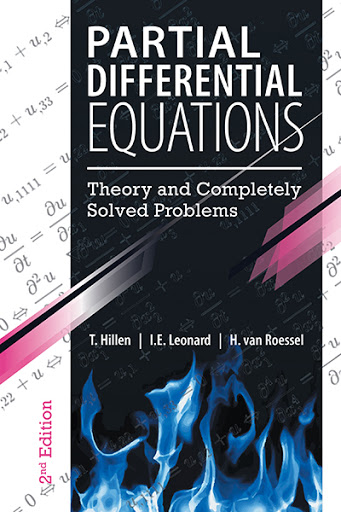|
|
||||||||||||||
|
|
||||||||||||||
|
Authors:
Friesen Press 2019
|
|||||||||||||
Now the 2nd Edition, at amazing low price:
Preface:
This textbook on linear partial differential equations (PDEs) consists of two parts. In Part I, we present the theory, with an emphasis on completely solved examples and intuition. In Part II, we present a collection of exercises containing over 150 explicitly solved problems for linear PDEs and boundary value problems. These problems are based on more than 30 years of collective experience in teaching introductory PDE courses at several North American universities. There are many excellent introductory textbooks on PDEs available, and over the years we have used the monographs by Asmar [4], Brown and Churchill [10], Haberman [24], Keane [30], and Powers [40], to name a few. These books give a concise, detailed, and easily accessible introduction to linear PDEs, and provide a number of solved examples. However, students always ask for additional problems with detailed solutions, and they tend to benefit from a drill-like repetition of problems and solutions. Here we address exactly this need. While Part I presents the theory behind linear PDEs and introduces the methods and techniques for solving them, the problems in Part II allow students to learn and repeat arguments in hands-on exercises. The problems in Part II of our textbook are all completely solved and explained in great detail. The final two chapters of this textbook contain four sample midterm examinations and four sample final examinations. These sample examinations are actual exams given between 2004 and 2009 at the University of Alberta. They provide students with a useful guideline as to what to expect as well as an opportunity to test their abilities. To help students use the text, we have incorporated two special features. First, we rank the problems according to their difficulty; of course, this is a subjective task, but it gives a good indication of the anticipated level of difficulty. We use: rank 1: X for very simple problems, rank 2: XX for simple problems, rank 3: XXX for more involved problems, and rank 4: XXXX for difficult problems. The second feature of the text is a detailed summary at the end of each chapter, with cross references to the solved problems in Part II. Most colleges and universities now teach undergraduate courses in boundary value problems, Fourier series, Laplace transforms or Fourier transforms, and then give applications to PDEs. The audience usually consists of third year students of mathematics, engineering, and other sciences. The requirements are a solid grounding in calculus, linear algebra, and elementary differential equations. Students need to be familiar with the methods and techniques for solving linear ordinary differential equations (ODEs). Many ODE courses do not cover advanced topics such as Bessel's equation or Legendre's equation, and hence we include a full treatment in the chapters that deal with PDE problems in polar and spherical coordinates. In the past, physics and engineering have been a major source of interesting PDE problems, nowadays problems come from other areas as well, such as mathematical biology. These problems address such topics as the spread of epidemics, survival or extinction of populations, or the invasion of healthy tissue by cancer cells, see, for example, [18]. Although not all PDEs can be solved by separation of variables or transform methods, most of this text focuses on these two methods. This is not surprising, since they form the backbone of any study of PDEs. Furthermore, the method of characteristics is also covered. A choice of topics had to be made, and we chose to focus on the above three methods: separation of variables, Fourier transforms, and the method of characteristics, and to illustrate them in great detail. Thus, topics not included are Greens functions or numerical methods. To prepare a syllabus for a one semester course using this text, we recommend the following: Chapters 1, 2, 3, 4, 5 Sections 6.1, 6.2, 6.6, 6.7, 7.1, 7.2, 7.4, 7.5 Chapters 8, 9, 10 Acknowledgements: We would like to thank our families for their support, without which this text could not have been written. TH would like to thank Lisa for her help in organizing and indexing the solved problems from Part II. IEL would like to thank Amanda for reading the entire manuscript numerous times. TH and IEL would especially like to thank Michael Keane for visiting Edmonton to discuss an earlier version of this text. We hope this textbook will provide useful assistance to all those interested in learning to solve linear PDEs and to get a glimpse of the beautiful theory behind them. Thomas, Ed, and Henry Edmonton, Alberta, CANADA March, 2012 Update 2019: We are saddened by the passing of our co-author Ed Leonard, who has not been able to witness the publication of the second edition with Friesen Press. We keep him in our memories. |
||||||||||||||
1st
edition with Wiley: 2012 - 2018
 |
T. Hillen, E.I. Leonard, H. van Roessel. Partial Differential Equations: Theory And Completely Solved Problems Wiley, 2012. |
|||||||||||||
